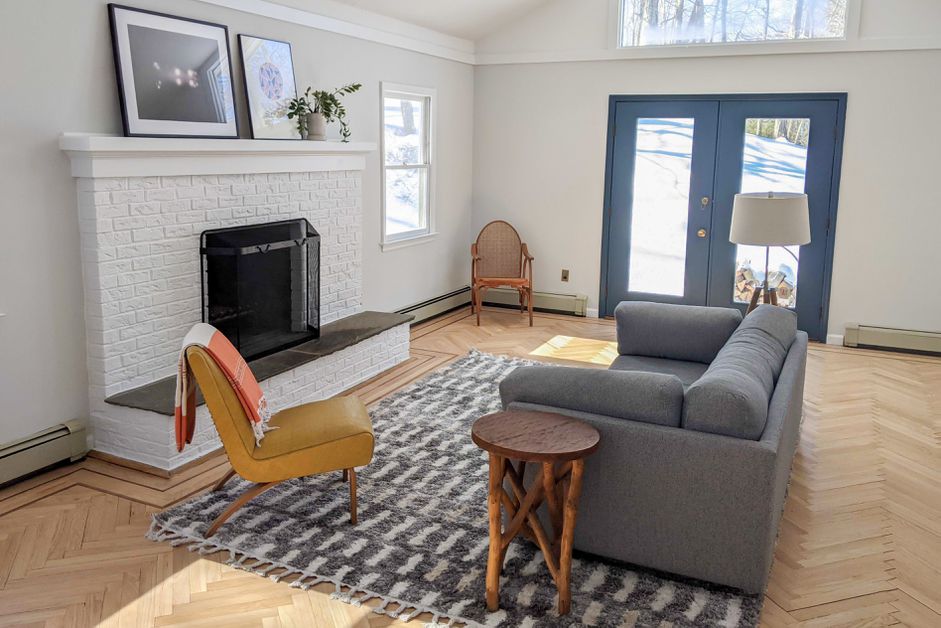A living room often serves as the social hub of a home, bringing family members together to talk, play, or relax. However, because of all that playing and relaxing, the flooring choice might be more important than in, say, the kitchen—after all, babies aren’t often scooting across the kitchen floor or taking falls when learning to walk nor are teens sprawling across the dining room floor while watching a movie.
Therefore, it can be quite important that living room floor is soft, comfortable, and cozy. Beyond that, though, durability, ease of cleaning, construction, and even color can make a big impact on choosing the besting carpeting for the living room.
Here are six factors to consider when choosing a carpet for your living room.

01 of 06
Durability
Because of the high-traffic nature of the family room, the carpet should be durable. Aside from stairs and hallways, family room floors typically receive the hardest use of any floor in the home. To ensure that your carpet will stand up to the wear and tear of everyday family life, look for a high-quality carpet that features a good wear warranty.
When shopping for the best carpet for the living room, quick test the quality of the product by bending the sample backward. If the backing easily shows, the low-density carpet is of lower quality and will crush faster.
A carpet’s durability is measured in face weight, tuft twist, and density rating. Look for a 34- to 40-ounce face weight, a tuft twist of 5 or more, and a density rating of 2,000 or higher. Additionally, note the difference between Bulked Continuous Filament (BCF) or staple fibers. The latter sheds more easily, which requires more vacuuming.
02 of 06
Fiber Options
The carpet fiber that you choose for the living room floor affects both the look and the durability of the carpet. Options include:
- Nylon: The most resilient carpet fiber, but it must be treated with a stain protector occasionally. The softest and strongest type is 6.6 nylon.
- Triextra: A fairly new type of fiber that’s partially derived from corn sugar. It has superior anti-stain properties and is also resilient. However, because it hasn’t been around as long as nylon, there isn’t yet a basis for comparison.
- Polyester: Also known as PET, this fiber is stain-resistant and cushy under the feet. However, it’s also hard to clean, sheds, and doesn’t last as long as other options. It will feel good on your feet, but it’s not ideal for high-traffic areas.
- Olefin: Inexpensive and resists fading, staining, and mildew. It’s not as durable or long-lasting as nylon, but it’s a good option for high-traffic areas.
03 of 6
Ease of Cleaning
Because the family room is one of the most-used rooms in the home, spills tend to happen with greater frequency here than in most other rooms except the kitchen. Having flooring that is easy to clean will make life in your family room much less anxious.
Consider a living room carpet that features a lifetime stain warranty. For best possible peace of mind, look for a carpet that has a “no exclusion” policy—meaning that substances commonly excluded from most stain warranties (such as pet accidents or bleach) are fully covered.
04 of 06
Carpet Construction
The construction of carpet can make a difference in the look of the living room. Construction factors include pile and style.
- Pile: Cut piles are also known as plush, while uncut piles are looped. Other options include a patterned loop, which has loops of multiple heights, and cut and loop, which creates a pattern.
- Style: Cut pile styles include smooth, texture, twist (also known as frieze), and shag. Smooth style looks the most formal, while twist and shag are the most casual. Loop pile styles include level loop, also known as berber—which is ideal for a high-traffic area because of its density—and patterned loop.
05 of 06
Fiber Softness
If your family typically ends up spending a lot of time on the floor, whether for playing board games or having sleep-overs, the softness of the carpet may be an important consideration. Most manufacturers today have a line of “soft” carpets, which feature much finer fibers than traditional carpet fibers.
Softness can also be achieved with the carpet cushion placed beneath the carpet. Many believe that, in order to be durable, an underpad must be quite firm. This is not necessarily true; however, it is possible to achieve a balance between softness and durability. Modern “memory foam” carpet padding can offer the best of both worlds—great durability as well as softness.
06 of 06
Color Selection
Selecting a color is a subjective decision. The carpet color you choose depends not only on your personal taste and décor style, but also on considerations such as the intended use of the room, the natural light exposure in the room, and possibly even the color of your pets (a carpet with a color that doesn’t show pet hair can be a real advantage).
Bold color choices can be fun but often become outdated. Neutral-colored carpets, including beige and gray, don’t go out of style. Warm colors, such as beige or red, create a cozy ambiance and hide stains.
Shop Smart
When shopping for carpet, get at least three estimates to ensure that you’re getting the best deal. Verify the quality of installation, as poor seaming, bad stretching, and a too-thin pad will ruin the look of new carpet.
